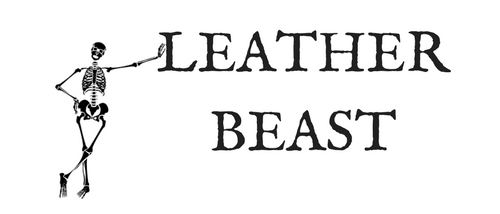Pricking Irons Vs. Stitching Chisels
When I first started learning traditional leatherwork I knew absolutely nothing about it, but I was eager to learn! I was taught by a French master leatherworker who only used the best French tools. Go figure!
She taught me the basics of traditional leatherwork which included how to use a tool called a pricking iron. But as I started experimenting with the other available tool options months and years later, I came across a tool called a stitching chisel and also a lot of viewpoints on which of these two tools is the best choice.
So lets go over each tool in detail including the pros/cons as well as sizes, brands and costs for each. Obviously the costs for leatherworking tools has a huge range - from high-end hand-forged European tools down to functional options for those that are on a shoe-string budget.
Rest assure, there is something for everyone!
Pricking Irons
A pricking iron resembles a fork in appearance with its multiple prongs at one end and skinny handle at the other. Each prong on the pricking iron is slanted at an angle (so that the user can create a slanted stitch) and these prongs can vary in number. A pricking iron is used to mark your stitches on your work enabling you to create even, equally spaced and symmetrically slanted stitches with the aide of a diamond point awl during stitching.
Pricking Iron Pros
Pricking irons, used to mark your stitches prior to saddle stitching, are a key element in creating the classic and beautiful slanted saddle-stitch - A telltale sign of a well made and often times luxury leather good.
In most traditional leatherworking circles it would be agreed that the pricking iron will give you the best looking and most refined stitch in appearance. It is the tool of choice for any of the remaining luxury leather goods manufacturers that still employ some hand-stitching in their products.
It’s pretty cool if you master a traditional tool like this, which will come with bragging rights, for sure.
Pricking Irons Cons
The tool itself is expensive, as you’ll see below. One set of a #12 and a #2 (the number indicates the number of prongs on the iron) cost me right around $250.
Because pricking irons only mark the stitches and do not actually create a hole to stitch through, you’ll also need a diamond point awl to assist you in creating the hole when saddle-stitching. This is another tool so thats obviously going to be an additional cost.
Using Pricking Irons does require more skill and practice of the user when saddle-stitching. Because you are creating the hole with the diamond point awl as you are stitching, you need to coordinate 2 needles and the awl in your hands all at the same time. You also need to make sure you’re inserting the awl into the work at the same angle each time. Any variation here, and it will be evident on the back of the work.
Pricking Iron Brand I use: Vergez Blanchard has been manufacturing their signature leatherworking hand tools since 1823. They are known for their high quality tools as a result of traditional hand forging methods that they use in the manufacturing process. They're at the top of their game when it comes to luxury leather tools, with Louis Vuitton and Hermès among their customer base.
Cost of pricking irons: $50-$200 depending on the size.
Cost of diamond point awl: $25
Pricking iron Sizes: I use the #12, #2 and #1 sizes. (the number indicates the number of prongs)
Stitching Chisels
Like pricking irons, stitching chisels main purpose is to set up your stitch placement on your work. Stitching chisels also resemble a fork and have slanted prongs to help you achieve those slanted stitches. The main difference between the irons and the chisels is that the chisels create an actual hole to stitch thought instead of just marking the stitch placement which removes the need for the additional tool during saddlestitching.
Stitching Chisels Pros
Stitching chisels are budget friendly. They might not be hand-forged and last a lifetime but if budget is a concern there are some good quality stitching chisels available.
Since the chisels pierce the leather all the way through and create a hole to stitch through, the use of a diamond point awl is NOT needed. Less tools = cost savings, yay!
Saddle-stitching becomes an easier process when using the chisels because the hole has already been made. This removes the need to use a diamond point awl while saddle-stitching and requires less coordination and skill during saddle-stitching.
Stitching Chisels Cons
As I mentioned above, when hard-pressed, your veteran traditional leatherworker will probably tell you that a properly wielded pricking iron will give you a better looking stitch. Many of them say that the stitches that the chisels create are flatter, not as slanted and thus not as aesthetically pleasing as the stitches created by using pricking irons. But having used both tools, I think the difference is fairly negligible so much so that I've switched over to using chisels almost 100% of the time. Only the eyes of another veteran leatherworker would probably be able to tell the difference.
Stitching chisel brand I use: I use the craftool pro line of stitching chisels.
Stitching chisel cost: $32-$45
Stitching chisel sizes: 88057-08 (8 prong) and 88056-02 (2 prong)
So, which will you choose?
The pricking irons that are more expensive, require more saddle-stitching skill but have arguably the most refined and best appearance OR the stitching chisels which are more affordable, easier to use but have a flatter (very slightly) less pleasing appearance?

